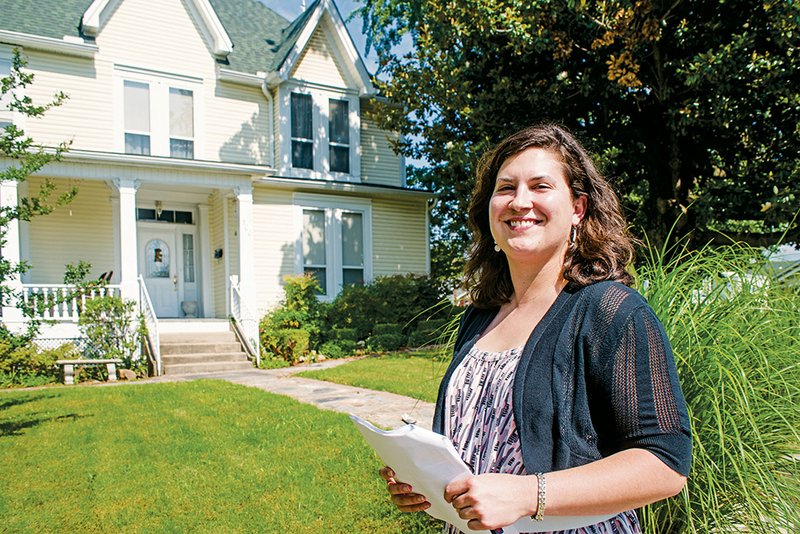MORRILTON — Just a few short blocks from the Morrilton Depot Museum at 101 E. Railroad Ave., the Moose Addition Historic District offers a glimpse of the past.
It’s here that visitors will find examples of homes built between 1881 and 1960 in a variety of architectural styles popular at the time, including Queen Anne, Craftsman, English/Tudor Revival, Colonial Revival and Plain/Traditional styles.
In an effort to showcase this district, the Arkansas Historic Preservation Program will conduct a Walks Through History Tour at 11 a.m. Saturday, beginning at the train depot museum. The Morrilton Historic District Commission will co-sponsor the event, which is free and open to the public.
“Morrilton has a ton of historic buildings,” said Rachel Silva, AHHP preservation outreach coordinator, who will lead Saturday’s walk. “The Moose Addition Historic District, which encompasses 31 buildings along South Division and South Moose streets between West Valley and Green streets, was listed in the National Register in 2013 for its association with early residential development in Morrilton.”
Silva said the historic district is also near several other buildings that are historically significant.
Silva said among those buildings are the railroad depot (now a museum), which was built in the early 1900s; the Conway County Courthouse at 117 S. Moose St., which was built in the Neoclassical style in 1883; the Conway County Library at 191 W. Church St., which was built with funds from an Andrew Carnegie Foundation grant and opened in 1916; and Saint Anthony’s Hospital at 202 E. Green St., which was built in 1937 in the Art Deco style and was used as a hospital until 1970 (it is now used for housing for adults with and without disabilities). All of these buildings are also individually listed on the National Register of Historic Places.
“We will also walk by the several churches located on Church Street,” Silva said.
Silva said the oldest home in the Moose Historic Addition is the G.L. Cunningham House at 300 S. Moose St.
“It is a Queen Anne-style house, built in about 1881,” Silva said. “It is the only example of a two-story Queen Anne home in the district. It has some of the original scrolls on the front porch.”
Silva said she conducts Walks Through History tours from March through December.
“I go to a different location every month,” she said. “The main purpose of these tours is to showcase and draw attention to each town’s unique history. I try to tell those who come for the tours something that they didn’t already know about their town.”
She said she welcomes inquiries from towns throughout the state.
“If we have never been to their town or haven’t been there in a few years, I am happy to work with them in setting up a tour. It doesn’t matter how small or how big the town is — if they have historic buildings, I will go.”
Silva said the Arkansas Historic Preservation Program administers the National Register of Historic Places program for Arkansas.
“The National Register is our country’s official list of significant sites worthy of preservation,” she said. “National Register listing is an honorary designation — it does not place restrictions on property owners.
“In order to qualify for listing, a property must be at least 50 years old, retain its historic integrity and be significant under one or more of the following criteria: A — associated with a broad event in our past; B — associated with a significant person; C — show exemplary design/architecture; and D — possess significant archeological value.”
Silva encourages owners of historic properties to maintain the upkeep of those properties and to apply for federal and state tax credits to help them.
“The federal and state historic rehabilitation tax-credit programs provide financial incentives for owners of National Register-listed properties,” she said.
“The Federal Historic Rehabilitation Tax Credit Program allows property owners to recoup 20 percent of the costs of renovating a historic building by way of a credit on their federal tax liability,” she said, noting the following guidelines: The property must be listed on or eligible for the National Register and be used for income-producing purposes (can be residential or commercial rental, etc.), and the work must be done in accordance with the Secretary of Interior’s Standards for Rehabilitation.
Silva said the State Historic Rehabilitation Tax Credit Program was passed in 2009 and created a State Historic Rehabilitation Tax Credit Program, which is very similar to the federal tax credit.
“But it’s a 25 percent tax credit,” Silva said, “and it is available to owners of income-producing properties, as well as private residences.
“If you qualify, you may take advantage of both the federal and state tax credits.”
Silva said there are other grant programs as well.
“County Courthouse Restoration Grants put bricks-and-mortar money into our National Register-listed county courthouses,” she said. “Our County Courthouse Grants have been used to restore historic county courthouses in 59 of the state’s 75 counties. We have awarded more than $17 million since the program started in 1989.
“In our past grant cycle (2013-2014), we awarded a courthouse grant to the Conway County Courthouse for parapet and window repair.”
Silva said Historic Preservation Restoration Grants, worth a minimum of $10,000, are available for National Register-listed properties owned by either a nonprofit organization or city and county governments. These are 1-2 matching grants.
For more information on these tax credits and grants, as well as Saturday’s Walks Through History Tour in Morrilton, contact Silva at (501) 324-9788 or rachels@arkansasheritage.org. More information is also available at www.arkansaspreservation.org.
